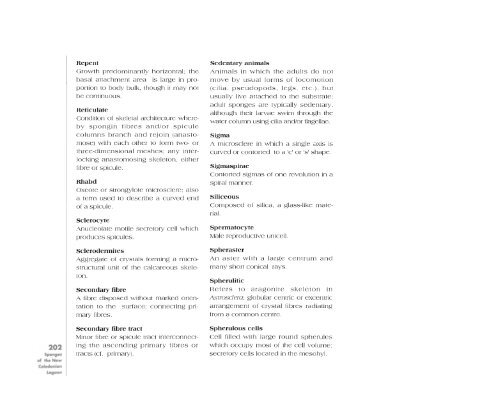Sponges of the New Caledonian lagoon - IRD
Sponges of the New Caledonian lagoon - IRD
Sponges of the New Caledonian lagoon - IRD
Create successful ePaper yourself
Turn your PDF publications into a flip-book with our unique Google optimized e-Paper software.
202<br />
<strong>Sponges</strong><br />
<strong>of</strong> <strong>the</strong> <strong>New</strong><br />
<strong>Caledonian</strong><br />
<strong>lagoon</strong><br />
Repent<br />
Growth predominantly horizontal; <strong>the</strong><br />
basal attachment area is large in proportion<br />
to body bulk, though it may not<br />
be continuous.<br />
Reticulate<br />
Condition <strong>of</strong> skeletal architecture whereby<br />
spongin fibres and/or spicule<br />
columns branch and rejoin (anastomose)<br />
with each o<strong>the</strong>r to form two- or<br />
three-dimensional meshes; any interlocking<br />
anastomosing skeleton, ei<strong>the</strong>r<br />
fibre or spicule.<br />
Rhabd<br />
Oxeote or strongylote microsclere; also<br />
a term used to describe a curved end<br />
<strong>of</strong> a spicule.<br />
Sclerocyte<br />
Anucleolate motile secretory cell which<br />
produces spicules.<br />
Sclerodermites<br />
Aggregate <strong>of</strong> crystals forming a microstructural<br />
unit <strong>of</strong> <strong>the</strong> calcareous skeleton.<br />
secondary fibre<br />
A fibre disposed without marked orientation<br />
to <strong>the</strong> surface; connecting primary<br />
fibres.<br />
Secondary fibre tract<br />
Minor fibre or spicule tract interconnecting<br />
<strong>the</strong> ascending primary fibres or<br />
tracts (cr. primary).<br />
Sedentary animals<br />
Animals in which <strong>the</strong> adults do not<br />
move by usual forms <strong>of</strong> locomotion<br />
(cilia, pseudopods, legs, etc.), but<br />
usually live attached to <strong>the</strong> substrate;<br />
adult sponges are typically sedentary,<br />
although <strong>the</strong>ir larvae swim through <strong>the</strong><br />
water column using cilia and/or f1agellae.<br />
Sigma<br />
A microsclere in which a single axis is<br />
curved or contorted to a 'c' or's' shape.<br />
Sigmaspirae<br />
Contorted sigmas <strong>of</strong> one revolution in a<br />
spiral manner.<br />
Siliceous<br />
Composed <strong>of</strong> silica, a glass-like material.<br />
Spermatocyte<br />
Male reproductive unicell.<br />
Spheraster<br />
An aster with a large centrum and<br />
many short conical rays.<br />
Spherulitic<br />
Refers to aragonite skeleton in<br />
Asrrosclero; globular centric or excentric<br />
arrangement <strong>of</strong> crystal fibres radiating<br />
from a common centre.<br />
Spherulous cells<br />
Cell filled with large round spherules<br />
which occupy most <strong>of</strong> <strong>the</strong> cell volume;<br />
secretory cells located in <strong>the</strong> mesohyl.

















